| April 7, 2010 |
|
Fast
and accurate
determination of the dry matter content in wood chips with dual energy
x-ray
Mikael
Hultnäs, PhD student, Swedish
University of Agricultural Sciences,
Uppsala, Sweden. Mikael provided an overview of the Department of
Forest Products and presented some key findings from his PhD project,
"Scaling of Pulpwood". He showed the extensive work done on testing the
accuracy of the Mantex
device which provides moisture content and thus dry weight in real time
(less than one minute). In other words, no need to heat the chip
samples in a vented oven for 24 hours. The device can also
spot
contamination of non-wood material, e.g., rocks and metal.
The device
has proven itself to be very accurate in Sweden, both in single specie
applications (spruce) and in mixed species (spruce and pine.
Click
here to view the presentation.
|
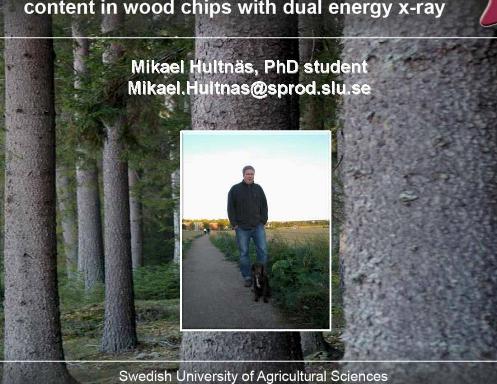 |
|
The
variability of
weight scaling results
Kim Iles, Kim
Iles and Associates, Nanaimo, British
Columbia. Kim gave us the view on statistical sampling that you don't
find in the text books. He pointed out that we typically
miscalculate the sampling error when determining the sample
size needed for sample cruising or sample scaling. There is
nothing wrong with systematic sampling, such as prior load
sampling in log scaling or grids and other systematic methods of
cruising. Determining the sampling error of these systematic methods,
with formulas designed for random samples will overestimate
the sample size needed. The 95% confidence limit
(t =2) is misleading, with a more realistic confidence limit being t =
0.7; Finally, the result of the above is that we generally
over sample. Click here to view the
presentation.
|
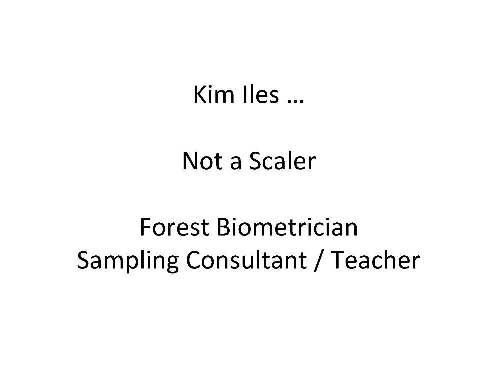
|
|
Rethinking
standard
taper rates for butt-cut logs
Eini
Lowell, USFS Pacific
Northwest Experiment
Station, Portland, Oregon. Eini showed the current
assumptions used in the USFS Region 6 taper tables for butt-cut logs
and how they compare with empirical data from other sources. Her
presentation focused on long (32'-40') lodgepole pine from regions
within and surrounding Eastern Washington. The results appeared to
indicate that the assumptions used in the Scaling Handbook for Region 6
east-side, Scribner scaling have the potential to overstate log volumes
by a significant amount. Further research is recommended and
needed. Click here to view the
presentation.
|
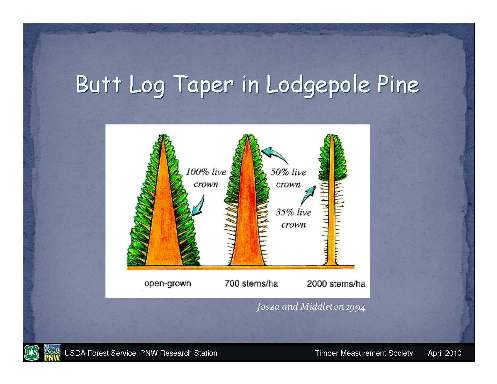
|
|
Onboard
truck weigh
scales as an alternative to using platform scales for weighing timber
Peter
Dyson, Researcher, FPInnovations
-Feric Division, Vancouver, British Columba. Peter gave the
background and results of a study that he worked on in the
Vancouver Island region of British Columbia. The aim of the
study was to assess the possibility of using onboard truck
weight scales as a substitute for platform scales. He showed
the advantages of using such a system and the results of their study
via a comparison of the net weight of the loads as measured by the
onboard truck scales vs. drive-on platform weight scales. The results
were very impressive, with 81% of the 280 loads (10, 644 tons or 9,654
tonnes) within + or - 1%. The total log weights as
measured by the onboard truck scales were +0.05% of what was determined
via the platform scales. Click here to view the
presentation.
|
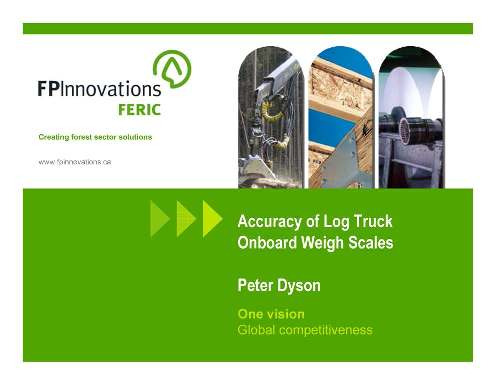
|
|
Interfor’s
efforts to improve efficiency in measuring logs
Bruce
Moran, Scaling Supervisor, Interfor,
Campbell
River, British
Columbia. Bruce presented the ongoing process at Interfor to gain
efficiency in their log scaling processes and how these relate to
efficiency in other areas of their operation. He reviewed past and
current methods and efforts at improved efficiency. A current
focus is scanner based log scaling. They currently have a Microtec log scanner installed in
their Acorn, B.C. sawmill and are looking toward this technology as an
important focus for future gains in log scaling efficiency. Click here to view the
presentation. |
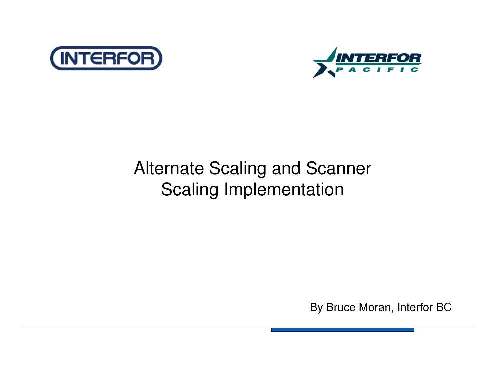
|
|
Measuring
biomass and other low value forest products
Frank Duran, R6 Measurements
Specialist, USFS,
Portland, Oregon. With the advent of bioenergy and other demands for
low valued fiber taken from the forest, the US Forest Service developed
a number of methods to measure these products. These were
developed with an eye to the accuracy standards, costs and the inherent
variability of measuring some of these products. The issues
and procedures that he covered were: "Low Value Policy" (June 2009), 3P
photo, slash piles, load count and weight, sample error policy and
random branch sampling. Click here to view the
presentation.
|
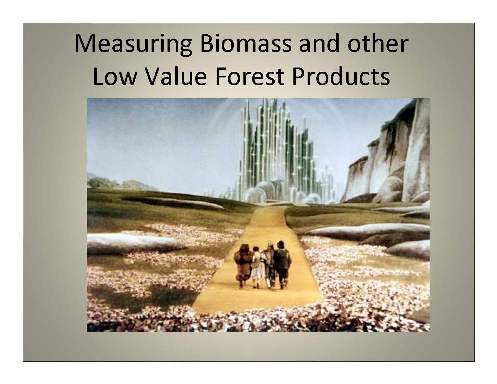
|
|
Measuring
logs on the
truck: keys to accurate and expedient truck scaling
Gary Baylous, Operations
Manager, Pacific
Rim Log Scaling Bureau, Lacy, Washington.
Gary presented the key ingredients necessary for accurate load volumes
when scaling on the truck. He showed the essentials in terms
of equipment, load presentation and scaling skills. Approximately 40%
of the volume that Pacific Rim scales is on the truck and when done
properly, truck scaling yields accurate volumes and provide some
advantages over ground scaling, in terms of reduced handling &
breakage. Click here to view the
presentation.
|
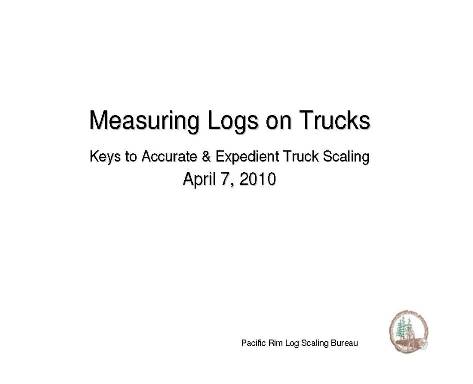
|
|
Log
scaling update
from New Zealand
John
Ellis, Group Technical Manager, C3 Ltd.; and Managing Director of
Scaling
Research International, Mount Maunganui, New Zealand. John gave us an
overview of forest management and harvest in New Zealand and C3's
scaling and log handling operations in New Zealand. He covered the
procedures used in the 3D method of scaling in New Zealand as
well as the 2D, JAS and Chinese systems. He also briefed us
on the situation with scaler employment, as well as standards used to
monitor scaling performance. |
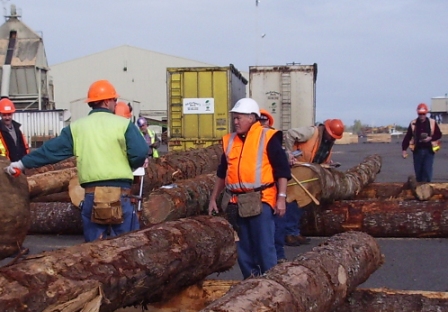
|
|
Logmeter,
drive
through log scanning for volume and log attributes
Mario
Angel, WoodTech -
North America, Portland, Oregon. Mario provided background on the
WoodTech company, which is based in Chile, as well as installations,
worldwide, where their products are currently being used. He
showed the comparative advantages of their scanners, which measure load
volumes in real time, when a truck drives through their scanning arch.
The scanners can differentiate logs and chips from the truck
and trailer and even measure attributes such as log diameter length and
imperfections such as crookedness. The scanning arch can be
used to view the visible characteristics of the load (external logs),
which can be used to extrapolate the hidden logs, or with the addition
of back lasers, it can measure logs inside the load. Volume accuracy is
very good and can be utilized to calculate a board foot volume as well.
Click here to view the
presentation. View a short video on the Logmeter 4000. |
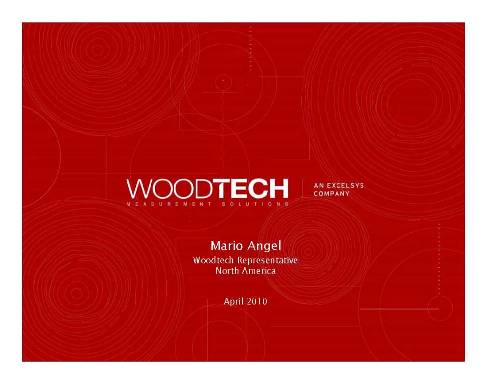 |
|
Tips for using the
latest technology for timber cruising
Bill Carr, LaserTech, Missoula, Montana.
Bill gave practical instruction on the use of the Impulse 200,
TruPulse 200/200B and 360/360B laser measuring devices for measuring
heights and distance, including procedures for those difficult
situations, such as through foliage or when the tree is leaning.
He also showed procedures for measuring crown cover and tree spacing.
He gave pointers on the use of the Criterion RD 1000
for measuring diameters (at different points on the stem) and variable
plot cruises. Finally he presented some of the useful accessories
that can be used with the impulse laser measuring devices, such as the
compass module and MapStar angle encoder. Click here to view the
presentation. |
 |
| April 8, 2010 |
|
Timber industry
economic forecast
Henry Spelter, USFS Forest Products Laboratory, Madison, Wisconsin.
Henry gave a concise overview on the current situation with
credit boom, the North American and world economy, and how this
situation is currently affecting the forest products industry. He
concludes that in North America, housing and construction will improve,
thus increasing demand, gradually given the population increase and
immigration rates projected and that by mid-decade, much of the lost
demand will be back. In addition to this, there are other factors
at play such as increased offshore demand (e.g., China) , reduced log
supply in some regions , such as will be the case in B.C. because of
the mountain pine beetle, which all point to the potential of a strong
rebound in the next 2-3 years. Click here to view the
presentation. |
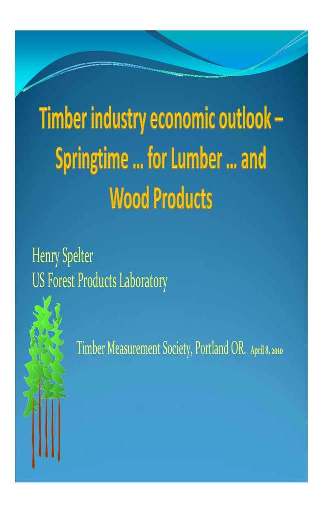 |
|
New USFS procedures
for using GPS on traverses surveys and new area determination standards
Gary Boyack, Forest Measurements Service Center, USFS, Fort Collins, Colorado. Gary reviewed the revisions being done to the Forest Service timber cruising handbook , FSH 2409.12,
section 50, which covers area determination used in timber cruising.
These include the use of GPS for the walk around method and the
corner method. The results of these revisions are that the new proven
technology and techniques are addressed and clarity has been improved
via the revision of confusing and conflicting instruction. Click here to view the
presentation.
Two Trails: a survey package for cruising
Gary also gave a presentation on a new beta surveying program for timber cruising, called Two Trails,
that they developed to assist cruisers: when GPS is not available, when
the canopy cover is too thick to get an accurate GPS reading, when in
deep canyons or when positional dilution of position (PDOP) is bad.
The system allows the mixed use of GPS and traditional traverse
survey. The program has companion versions in PC and mobile CE
format. It is freeware and is available free of charge here. Click here to view the
presentation on Two Trails.
|
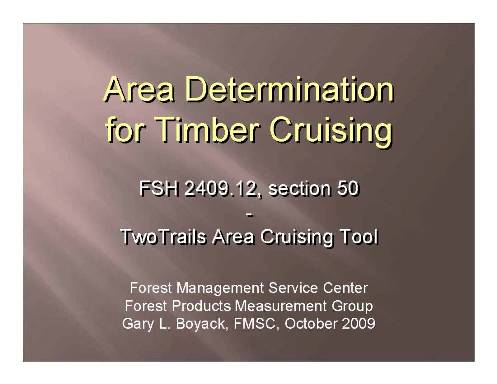 |
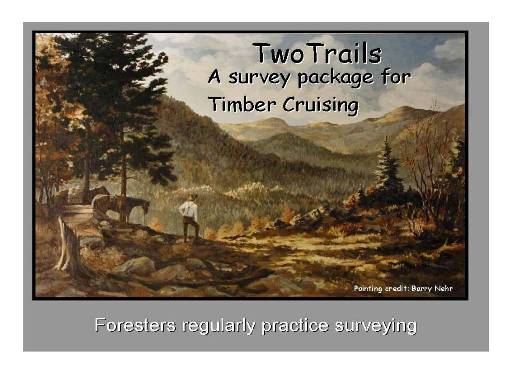 |
|
Return-to-log models
for procurement and planning (product volume and value recovery)
Roy Anderson,
Senior Consultant, Beck Group, Portland
Oregon.
Roy gave a brief description of the services that the Beck
Group provides and then focused on RTL (return to log models). He
described that an RTL is an extremely useful tool for a mill or
seller to determine the worth of logs of a particular species, size and
grade. The model can be used for calculating what a mill can pay for
logs (stumpage and at the mill gate) given a desired profit and risk
margin, and it can be used as a tool for modeling possible scenarios,
such as different products, or different units of log volume measure,
etc. He described the process used to populate the model with
information that is taken from log tests and operation expenses
(milling and harvest and haul). Finally he described why there is so
much variation in log value as a result of diameter. Click here to view the
presentation. |
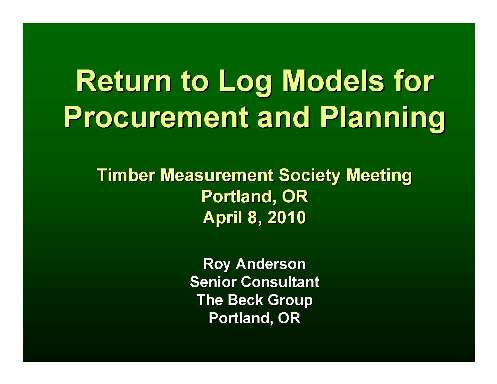 |
|
Log
yard inventory measurements: lessons learned
John Calkins, Scaling Supervision,
Simpson Timber Company,
Shelton, Washington. John presented the lessons that he has
learned while working on improving the physical log yard inventory
methods. The focus of this work was being able to accurately assess the
stacked measure volume of the log decks by taking accurate heights and
lengths (widths were known from the loads that went into inventory).
Additionally, it was important to come up with a system that one person
could do efficiently, that was straightforward to all, including
auditors, and thus could be replicated and checked. After many
trials with different systems, the TruPulse 360 appears to be the
perfect tool to accomplish these aims. Click here to view the
presentation. |
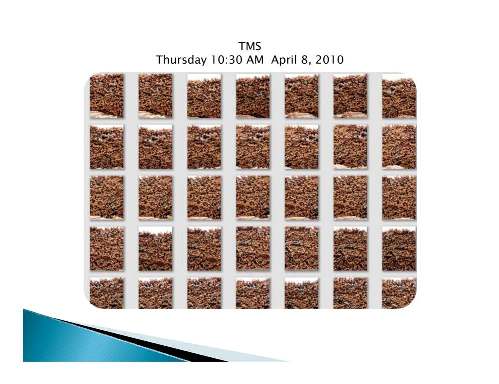 |
|
Using the Laser
Rangefinder for measuring log decks
Jon Aschenbach,
Resource Supply LLC.,
Beaverton, Oregon. Picking up where John Calkins left off, Jon
Aschenbach gave a presentation on the methods of using laser
rangefinders, such as the TruPulse 360 for measuring log deck volume.
Some of the advantages of this technology, over the old tape and
measuring staff, is that it reduces the time needed to measure a deck,
one person operation, can measure a wide variety of log decks, is
repeatable, accurate and can be safer. Jon has developed software and
techniques for using the laser rangefinder for log deck measurements
and was especially excited about the capabilities of rangefinders, such
as the TruPulse 360B which has a built in compass, which allows one to
shoot deck dimensions in numerous places on the deck from one
location. Click here to view the
presentation. |
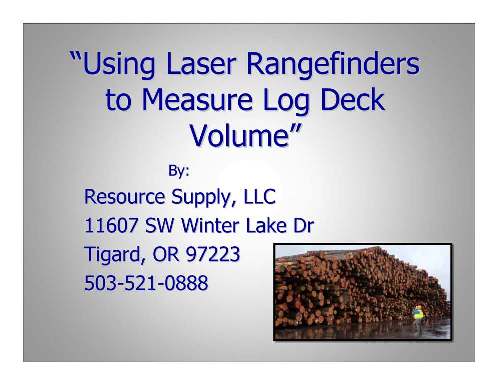 |
|
The
use of CTLs, pre-bundling and weight to volume ratios in helicopter logging
David Horrax, Forester,
Columbia Helicopters Inc.,
Portland, Oregon. Typically, helicopter logging is associated
with areas where no mechanized equipment can access and thus logs tend
to be scattered randomly, often requiring complex and varied cable
hookups. Recently, however, Columbia has been hired to harvest some
sales where it was possible to get cut-to-length harvesters into the
sale area. This significantly increased production, as logs could be
pre-bundled and more fully manufactured (no limbs, etc.). In addition
the CTLs are able to calculate cubic meters of log volume, which allows
the use of weight to volume ratios to determine accurate log turn
weights, thus capatalizing on potential pay load capacity. Click here to view the
presentation. View a short video on heli-logging pre-bundled log turns. |
 |
|
Is there a better way
to measure timber than the board foot?
Neal Hart,
Jendro & Hart LLC, Sunriver, Oregon. Neal made a compelling case
for cubic log scale rather than the board foot. He presented some of
the misconceptions regarding the board foot rules, such as: that board
foot log is the same as board foot lumber and that there is a single
factor for converting between cubic volume and board foot. Interestingly
enough he showed that two of the most common and erroneous assumptions
regarding cubic to mbf conversions (4.53 m3 = 1 mbf log volume; 2.36 m3
= 1 mbf lumber volume) are still used quoted and cited. He
pointed out that it is almost impossible to make any meaningful
analysis of mill recovery using board foot log measure and that many
costly mistakes have been made in the past as a result of the volume
misrepresentation of the board foot log rules. Click here to view the
presentation. |
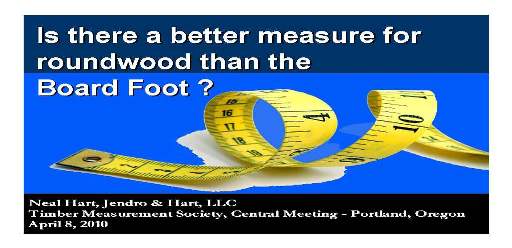 |
|
Western hardwoods overview:
log measurement issues, value drivers, manufacturing
Rob Johnson, Western
Hardwood Association,
Camas, Washington. Rob presented an overview of the hardwood industry
in the Pacific Northwest, from the log yard to the final product. There
are six major species (and many more minor ones) of hardwoods processed
in the Pacific Northwest: red alder (by far the most important), big
leaf maple, birch, western ash, black cottonwood, and pacific albus
(which is a hybrid poplar grown in plantations). He showed the typical
merchandising and manufacturing process. Finally, he explained that
alder is typically graded under proprietary rules and since it finds
its highest worth and biggest demand in appearance applications rather
than structural, the grade is rather demanding, with fall down ending
up as pallet stock or chips. Click here to view the
presentation. |
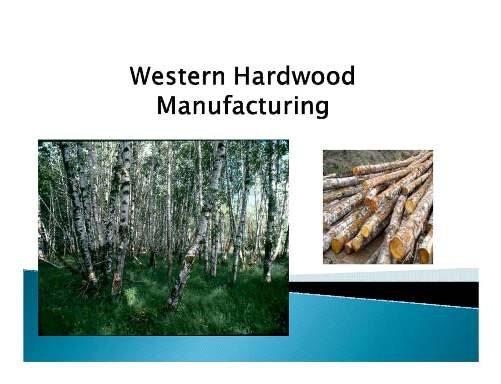 |
|
Measuring carbon for
commercial purposes in wood and the forest
Steve Fairweather, Mason Bruce
& Girard, Portland, Oregon. Steve
presented his experience in conducting forest inventories for small
landowners at an accuracy standard that meets the requirements of the
Chicago Climate Exchange (CCX). The rules of the CCX stipulate
that the inventory estimate must have a 90% confidence interval that is
no larger than + or - 10%, the inventory must work with the Forest
Vegetation Simulator (FVS) growth model, and must be capable of
verification by CCX approved auditors. Two important pointers in
meeting the CCX standards is to stratify stands and consider using
large plots rather than small ones, as this will reduce
variability. Click here to view the
presentation. |
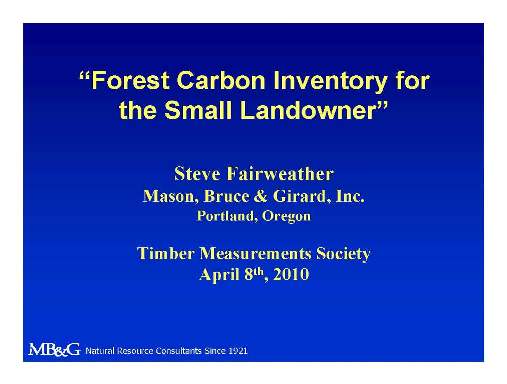 |
|
The challenges and choices for woodland owners in a "cap and trade" world
Mike Gaudern Portland, Woodlands Carbon
Company,
Salem, Oregon. Mike gave an overview of the work that Woodland Carbon
does to assist small landowners in getting into the voluntary carbon
market. This is accomplished by pooling together small forest blocks
held by individual landowners and assisting them with the forest
management options and inventory process. In addition, mike gave us an
overview of the process of getting paid to increase the carbon
storage in your timber stand and pointed out three important steps
in achieving this: develop a forest management plan that
increases the carbon storage of your forest, get certified (e.g.,
American Tree Farms), and conduct a forest inventory. Click here to view the
presentation. |
 |
|
CT scanning (computer
tomography): optimization technology that can measure and map defects inside of
logs
Konrad Tschurtschenthaler, Microtec, Brixen, Italy. Konrad gave everybody an
introduction to Microtec. He
gave the historical background on the discovery, logic and use of the
x-ray, and provided an explanation on the technical application of this
technology to measure and map internal defects , such as decay, metal,
pitch pockets, knots, checks, shake, sapwood, heartwood and bark. This
technology (Tomolog) will not only allow the proper measurement
and net volume estimation, but will give a new form of mill
optimization whereby the mill can maximize grade yield. The log is
simply run through a scanner (even at high feed speeds) and the size
and location of the defects are known. The potential for this
technology is huge - on all accounts. Click here to view the
presentation. |
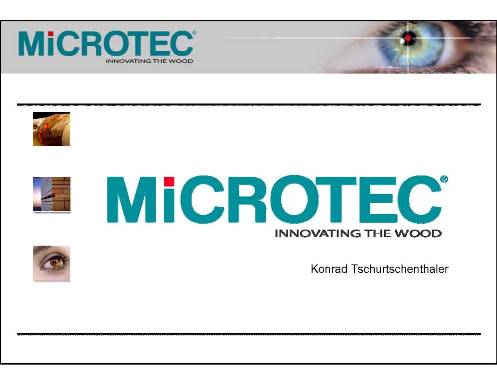 |
|
Scaling profile:
Hampton Affiliates
Richard Wilfong, Scaling Supervisor, Hampton Affiliates,
Salem, Oregon. Rich gave us a view into their operations in the US
(they also are in Canada), focusing on the five sawmills that they
operate in Oregon and Washington (Willamina, Tillamook, Morton, Randle,
Darrington). He briefed us on the size of their operations, log
yard and scaling ramp procedures as well as how they communicate and
receive data from the two scaling bureaus (Yamhill and Pacific Rim)
that take care of their scaling. They have an excellent log
information system, which is populated daily with deliveries , which
can be used to estimate inventory, spot any log quality issues from the
sale area and take care of any questions that they might have regarding
log attributes. Click here to view the
presentation. |
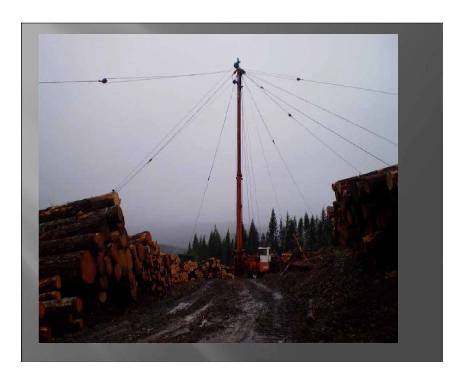 |
|
Bi-directional transfer of data and support files between the
hand held scale software on an Allegro MX
David Dean, Electornic Data Solutions, Jerome, Idaho. In
prior versions of their log scale systems, data, programs, and support files were
exchanged between the hand held scale software and the PC support software,
DataLink CE, with either ActiveSync, phone modem, or direct serial
connection. They now
have the ability to transfer data, programs, and support files over the internet
to DataLink CE using TCP/IP. David
demonstrated the bi-directional transfer of data and support files between the
hand held scale software on an Allegro MX at our meetings in Portland to a
laptop running DataLink CE in Jerome Idaho using our office internet connection. The
hand held connected to the internet using the wireless network in the
motel.
|
 |
|
Forest product conversion
factors for North America and Europe: Why do sawmills in Europe average 56%
recovery,
and in North America only 47%?
Matt Fonseca, UNECE/FAO Timber Section,
Geneva Switzerland. Matt gave a presentation on the work that is
ongoing in the UNECE Timber section in the area for forest products
data harmonization which is important in understanding conversion
factors. The UNECE/FAO uses conversion factors for periodic "forest sector outlook studies" as well as for checking the accuracy of data that goes into the "timber database",
which has forest products production and trade statistics for North
America and Europe. The Timber Section recently completed a publication
on forest product conversion factors (Forest Product Conversion Factors for the UNECE Region).
Country experts (most of which were members of the Task Force on Forest
Products Conversion Factors) and correspondents submitted their
ratios. The results were interesting in that differences in the way
volumes are determined and at what point in the manufacturing process
(primarily roundwood and sawnwood) likely cause much of this
difference. In addition there is a short presentation on some of
the key findings of this project, which would suggest changes need to
be made to conversion factors that are used internally and printed as a
general guide in other publications. Click here to view the
presentation on conversion factors and here to view the presentation on data harmonization. |
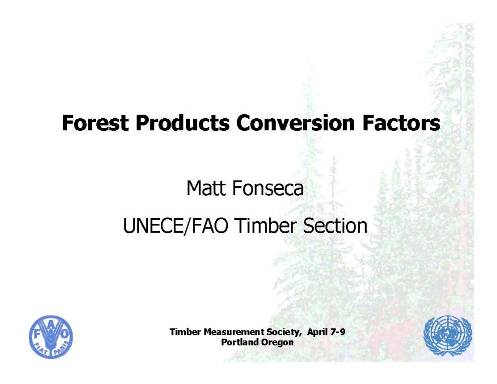 |
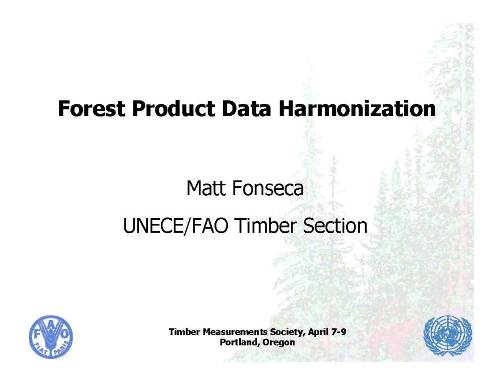 |
| April 9, 2010 |
On April 9,
we had a field trip to the interfor mill in Mollala Oregon. Most took a
tour of the mill and participated in a comparison scale on a group of
35 logs. The logs included mix of typical Douglas fir and western
hemlock logs that are used at this mill, however, there were a number
of other species and large, highly defective logs thrown in to make
things interesting. This included a large western red cedar that was a
borderline cull or merchantable log (depending on how far the rot ran
up the log) as well as a large western hemlock log with twist and frost
cracks, which was considered to be cull by some and merchantable by
others. The median numbers for the logs were as follows:
|
BC
Firmwood m3
|
NZ 3-D m3
|
JAS m3
|
NWLRAG ft3
|
USFS ft3
|
Scribner Long log bf
|
Scribner Short log bf
|
|
Gross
|
Net
|
Gross
|
Net
|
Gross
|
Net
|
Gross
|
Net
|
Gross
|
Net
|
Gross
|
Net
|
Gross
|
Net
|
|
39.557
|
39.557
|
42.918
|
42.918
|
42.52
|
42.52
|
1607
|
1474
|
1394
|
1090
|
7155
|
4450
|
8710
|
6220
|
Given the small sample size
and the very high percentage of defect, which was not
representative, these numbers should not be used as any kind of an
indication as to conversion factors from one method to another, but
they are very interesting. It should be noted that there are
substantial differences in how these rules are applied. BC firmwood
only accounts for void, soft-rot and char, New Zealand 3-D and JAS are
not accounting for defect, while the NWLRAG cubic, USFS cubic, and the
two Scribner rules deduct for virtually all defects that reduce lumber
recovery, such as many firm defects, e.g., shake, cracks, crook, etc.
After the field trip, the group had a lunch at a local cafe in Molalla. The meeting was adjourned at about 2:30 PM.
|
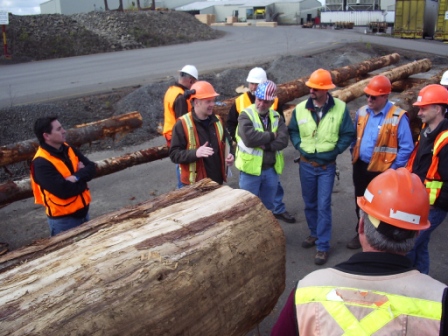 |
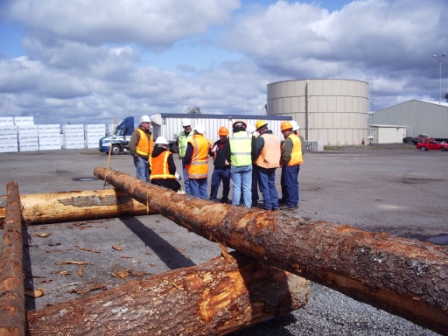 |
|























